
The Committee for Skeptical Inquiry (CSI), formerly known as the Committee for the Scientific Investigation of Claims of the Paranormal (CSICOP), is a program within the US non-profit organization Center for Inquiry (CFI), which seeks to "promote scientific inquiry, critical investigation, and the use of reason in examining controversial and extraordinary claims." Paul Kurtz proposed the establishment of CSICOP in 1976 as an independent non-profit organization, to counter what he regarded as an uncritical acceptance of, and support for, paranormal claims by both the media and society in general. Its philosophical position is one of scientific skepticism. CSI's fellows have included notable scientists, Nobel laureates, philosophers, psychologists, educators and authors. It is headquartered in Amherst, New York.
Skeptical Inquirer is a bimonthly American general-audience magazine published by the Committee for Skeptical Inquiry (CSI) with the subtitle: The Magazine for Science and Reason.
Scientific skepticism or rational skepticism, sometimes referred to as skeptical inquiry, is a position in which one questions the veracity of claims lacking empirical evidence. In practice, the term most commonly references the examination of claims and theories that appear to be beyond mainstream science, rather than the routine discussions and challenges among scientists. Scientific skepticism differs from philosophical skepticism, which questions humans' ability to claim any knowledge about the nature of the world and how they perceive it, and the similar but distinct methodological skepticism, which is a systematic process of being skeptical about the truth of one's beliefs.

Michael Brant Shermer is an American science writer, historian of science, executive director of The Skeptics Society, and founding publisher of Skeptic magazine, a publication focused on investigating pseudoscientific and supernatural claims. The author of over a dozen books, Shermer is known for engaging in debates on pseudoscience and religion in which he emphasizes scientific skepticism.
The Skeptics Society is a nonprofit, member-supported organization devoted to promoting scientific skepticism and resisting the spread of pseudoscience, superstition, and irrational beliefs. The Skeptics Society was co-founded by Michael Shermer and Pat Linse as a Los Angeles-area skeptical group to replace the defunct Southern California Skeptics. After the success of its magazine, Skeptic, introduced in early 1992, it became a national and then international organization. The stated mission of Skeptics Society and Skeptic magazine "is the investigation of science and pseudoscience controversies, and the promotion of critical thinking."
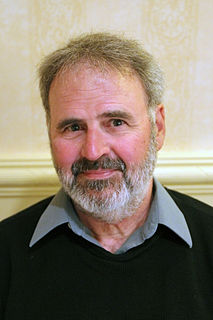
Robert Todd Carroll was an American writer and academic, best known for The Skeptic's Dictionary. He described himself as a naturalist, an atheist, a materialist, a metaphysical libertarian, and a positivist. In 2010 he was elected a fellow of the Committee for Skeptical Inquiry. He was a professor of philosophy at Sacramento City College from 1977 until his retirement in 2007.

The Amazing Meeting (TAM), stylized as The Amaz!ng Meeting, was an annual conference that focused on science, skepticism, and critical thinking; it was held for twelve years. The conference started in 2003 and was sponsored by the James Randi Educational Foundation (JREF). Perennial speakers included Penn & Teller, Phil Plait, Michael Shermer and James "The Amazing" Randi. Speakers at the four-day conference were selected from a variety of disciplines including scientific educators, magicians, and community activists. Outside the plenary sessions the conference included workshops, additional panel discussions, music and magic performances and live taping of podcasts including The Skeptics' Guide to the Universe. The final Amazing Meeting was held in July 2015.
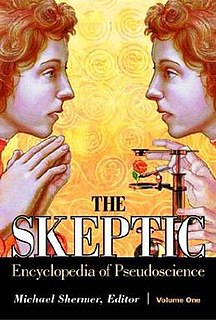
The Skeptic Encyclopedia of Pseudoscience is a two-volume collection of articles that discuss the Skeptics Society's scientific findings of investigations into pseudoscientific and supernatural claims. The editor, Michael Shermer, director of the Skeptics Society, has compiled articles originally published in Skeptic magazine with some conceptual overviews and historical documents to create this encyclopedia. It was published by ABC-CLIO in 2002.
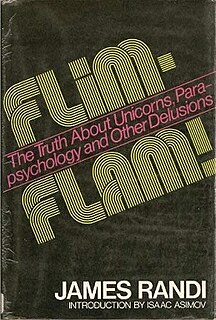
Flim-Flam! Psychics, ESP, Unicorns, and Other Delusions is a 1980 book by magician and skeptic James Randi about paranormal, occult, and pseudoscience claims. The foreword is by science fiction author Isaac Asimov. Randi explores topics which he says that scientists and the media are too willing to promote without skepticism and proper expertise.

Daniel Loxton is a Canadian writer, illustrator, and skeptic. He wrote or co-wrote several books including Tales of Prehistoric Life, a children's science trilogy, and Abominable Science!, a scientific look at cryptozoology. As editor of Junior Skeptic, Loxton writes and illustrates most issues of Junior Skeptic, a children's science section in the Skeptics Society's Skeptic magazine.

Kylie Sturgess is a past President of the Atheist Foundation of Australia, an award-winning blogger, author and independent podcast host of The Token Skeptic Podcast. A Philosophy and Religious Education teacher with over ten years experience in education, Sturgess has lectured on teaching critical thinking, feminism, new media and anomalistic beliefs worldwide. She is a Member of the James Randi Educational Foundation (JREF) Education Advisory Panel and regularly writes editorial for numerous publications, and has spoken at The Amazing Meeting Las Vegas, Dragon*Con (US), QED Con (UK). She was a presenter and Master of Ceremonies for the 2010 Global Atheist Convention and returned to the role in 2012. Her most recent book The Scope of Skepticism was released in 2012. She is a presenter at Perth's community radio station RTRFM, and a winner at the 2018 CBAA Community Radio Awards in the category of Talks, with the show Talk the Talk In 2020 she was in the final eight in the Three-Minute Thesis (3MT) Asia-Pacific virtual showcase.

Desiree Schell is the host of the live Canadian call-in radio talk show and podcast "Science for the People". An advocate for scientific skepticism, Schell is a strong advocate of critical thinking and is strongly interested in the promotion of skepticism publicly. In her work as a labour organizer, Schell creates curricula and teaches courses on effective activism, drawing on the experience of other social movements.

Karen Stollznow is an Australian-American writer, linguist, and skeptic. Her books include The Language of Discrimination, God Bless America: Strange and Unusual Religious Beliefs and Practices in the United States, Haunting America, Language Myths, Mysteries and Magic, Hits and Mrs, and Would You Believe It?: Mysterious Tales From People You'd Least Expect. She also writes short stories, and is a host on the podcast Monster Talk.

MonsterTalk is an audio podcast originally presented by the Skeptics Society's Skeptic magazine but broke ties in 2019. Since 2019 it has been an independent podcast under the "Monster House, LLC" banner. The show critically examines the science behind cryptozoological creatures, such as Bigfoot, the Loch Ness Monster, and werewolves. It is hosted by Blake Smith and Karen Stollznow, and produced by Blake Smith. In 2012, MonsterTalk was awarded the Parsec Award for the "Best Fact Behind the Fiction Podcast".
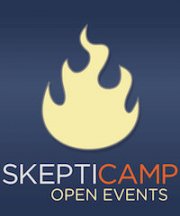
SkeptiCamp was founded by Reed Esau in 2007 and is small grassroots conference where scientific skeptics come together and participate and present. Skepticamps are held in varying formats worldwide and are operated in the style of an unconference.
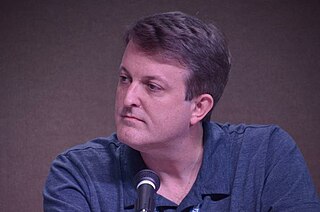
Timothy Patrick Farley is a computer software engineer, writer and instructor who lives in Atlanta, Georgia. He is an expert in computer security and reverse engineering as well as a skeptic. He was a research fellow of the James Randi Educational Foundation. Tim Farley is the creator of the website What's The Harm?, a resource where stories are documented and categorized about the damage done when people fail to use critical thinking skills. Farley was also instrumental in the apprehension of spammer "David Mabus."
Scientific skepticism is the practice of questioning whether claims are supported by empirical research and have reproducibility, as part of a methodological norm pursuing "the extension of certified knowledge". Scientific skepticism, or skepticism for short, manifests itself since the 20th century as a societal phenomenon involving several individuals and more or less organised groups through several different media, commonly referred to as "the skeptical movement". This is a compilation of the various lists about skepticism with articles in Wikipedia.

CSICon or CSIConference is an annual skeptical conference typically held in the United States. CSICon is hosted by the Committee for Skeptical Inquiry (CSI), which is a program of the Center for Inquiry (CFI). CSI publishes the magazine Skeptical Inquirer.













